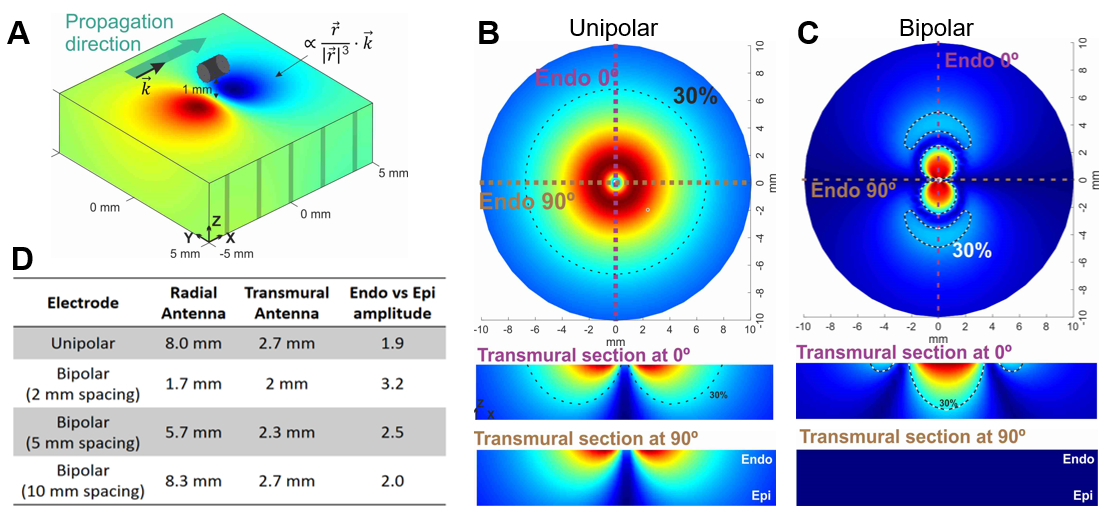Final ID: Mo2142
Field of View of Atrial Electrodes by Endocardial and Epicardial Computer Mapping
Abstract Body (Do not enter title and authors here): Background:
Mapping atrial fibrillation (AF) electrograms at each position on a multipolar catheter is complicated by the impact of far-field signals from colliding and chaotic wavelets. The actual field of view of unipolar and bipolar electrodes of different sizes and separations is undefined, yet may substantially impact recorded AF maps.
Hypothesis:
We tested the hypothesis that the field of view (antenna) of EGMs can be defined based on the size of electrode, their spacing, and tissue characteristics including conduction velocity using biophysical models of active myocardial tissue.
Methods:
We modeled conduction in atrial tissue of size 30 x 30 x 3 mm, to estimate the region around clinical AdvisorTM HDGrid (Abbott), OctarayTM or OptrellTM (Biosense-Webster) multipolar catheters. We tested various 1 mm electrode configurations, separated by 2 mm, 5 mm and 10 mm. Using models discretized into 100,000 and 100 nodes, we varied conduction velocities and propagation directions to simulate myocardial propagation (fig. A). The EGM was constructed using the electric potential transfer equation between the tissue and the electrode, discretized for each tissue node to evaluate individual contributions of atrial regions to unipolar and bipolar EGMs. We defined the spatial near field as regions contributing > 30% of signal amplitude.
Results:
Transverse recording antenna varied substantially with bipolar configuration. In Figure B, the unipolar electrode recorded near field activity within a 3D ellipsoid of radius 8 mm across-tissue and 2.7 mm transmurally with a 1.9 endo-to-epicardial amplitude ratio. Bipolar electrodes showed directional antennas for near field, aligned with the propagation direction (fig. C) with radii of 1.7, 5.7 and 8.3 mm for 2, 5, and 10 mm spacing, respectively (fig. C). Bipolar electrodes showed less transmural variability in near field antenna (range 2-2.7 mm), which was similar to unipolar (fig. D).
Conclusions:
Current generation multipolar catheters may record apparently “near field” signals in relatively large ellipsoids/spheres of radius 1.7 to ~8 mm. This may substantially impact signal fidelity when the same wave is not present throughout this volume, such as in AF or ventricular fibrillation, and may impact noise detection for atrial and ventricular tachycardia. Signal processing techniques are required to improve near field signal detection.
Mapping atrial fibrillation (AF) electrograms at each position on a multipolar catheter is complicated by the impact of far-field signals from colliding and chaotic wavelets. The actual field of view of unipolar and bipolar electrodes of different sizes and separations is undefined, yet may substantially impact recorded AF maps.
Hypothesis:
We tested the hypothesis that the field of view (antenna) of EGMs can be defined based on the size of electrode, their spacing, and tissue characteristics including conduction velocity using biophysical models of active myocardial tissue.
Methods:
We modeled conduction in atrial tissue of size 30 x 30 x 3 mm, to estimate the region around clinical AdvisorTM HDGrid (Abbott), OctarayTM or OptrellTM (Biosense-Webster) multipolar catheters. We tested various 1 mm electrode configurations, separated by 2 mm, 5 mm and 10 mm. Using models discretized into 100,000 and 100 nodes, we varied conduction velocities and propagation directions to simulate myocardial propagation (fig. A). The EGM was constructed using the electric potential transfer equation between the tissue and the electrode, discretized for each tissue node to evaluate individual contributions of atrial regions to unipolar and bipolar EGMs. We defined the spatial near field as regions contributing > 30% of signal amplitude.
Results:
Transverse recording antenna varied substantially with bipolar configuration. In Figure B, the unipolar electrode recorded near field activity within a 3D ellipsoid of radius 8 mm across-tissue and 2.7 mm transmurally with a 1.9 endo-to-epicardial amplitude ratio. Bipolar electrodes showed directional antennas for near field, aligned with the propagation direction (fig. C) with radii of 1.7, 5.7 and 8.3 mm for 2, 5, and 10 mm spacing, respectively (fig. C). Bipolar electrodes showed less transmural variability in near field antenna (range 2-2.7 mm), which was similar to unipolar (fig. D).
Conclusions:
Current generation multipolar catheters may record apparently “near field” signals in relatively large ellipsoids/spheres of radius 1.7 to ~8 mm. This may substantially impact signal fidelity when the same wave is not present throughout this volume, such as in AF or ventricular fibrillation, and may impact noise detection for atrial and ventricular tachycardia. Signal processing techniques are required to improve near field signal detection.
More abstracts on this topic:
Association between Glucagon-like peptide-1 receptor agonists and risk of Arrhythmias: A Contemporary Real-World Analysis
Jaiswal Vikash, Hanif Muhammad, Goyal Aman, Yasmin Juveria, Deb Novonil, Mashkoor Yusra, Rajak Kripa, Mattumpuram Jishanth, Weinberg Andrew
Anti-Arrhythmic drugs versus Catheter Ablation Prognostic value in the patients with Diastolic Heart Failure and Atrial Fibrillation: a Systematic Review and Meta-analysis of 38,237 PatientsChichagi Fatemeh, Ghanbari Kimiya, Arbabi Mahta, Shirsalimi Niyousha, Sheikh Mahboobeh, Mohammadi Amirali, Alikhani Reyhaneh, Mombeini Hoda

